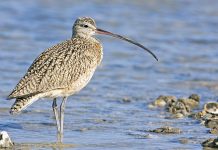In Australia, most Emerald Ground-doves (Chalcophaps indica) are found in eastern coastal rainforests, although the birds occasionally visit wet sclerophyll forests and coastal heaths. In the Northern Territory, they live mainly in monsoon forests. Ground-doves are primarily forest floor birds, but they also frequent regrowth, overgrown clearings, and lantana-choked country, and they often feed on small isolated scrub patches. It is also known as a green-winged pigeon, Asian Emerald Dove, Green Dove, Little Green Pigeon, grey-capped emerald dove, and Emerald Dove. A quiet bird, usually found alone or in a small group.
Apart from feeding on the ground, the doves also walk along thick branches of trees and take any fruit that is within their reach. Fruit pigeons, on the other hand, cling to foliage. Inkweed, wild tobacco, wild raspberry, lantana, figs, and a variety of falling seeds are among the food sources of these doves. The Emerald Ground Dove gathers in small groups in clearings but is usually a solitary bird. You can sometimes see them walking along jungle tracks, flying across open areas, and even swimming along scrubby creeks. The size of the Emerald Ground-Dove is 260-280 mm long. The Emerald Ground-Dove call is a low-pitched, loud, penetrating coo repeated continuously as a territorial call. Also a soft, explosive coo on display.
Their flight is strong, swift, and heavy, like a bronze wing. Travelling at high speed from cover to cover, they beat their wings continuously and keep close to the ground. In the rainforest, they fly between the trees, maneuvering quickly and easily between the trunks. As with all pigeons, males have a bow-like display posture, which they use in sexual or aggressive situations. The Emerald Ground-Dove also performs the bowing display to advertise itself. It flies up to a branch, lowers its head and breast slightly, and makes its main movement with its tail and lower belly. It swings them up to an angle of 45-60 degrees and then down again, repeating this 15-20 times in a perfectly even rhythm.

The result is eye-catching, and nearly always a female trots out of the undergrowth and perches beside the male. He then performs a rapid bobbing display and copulation often follows. Both sexes incubate the eggs, the female during the night and the male during the day. However, females occasionally find nests at midday. The birds change over in the morning and late afternoon, but there is no obvious relief ceremony-the incoming partner merely arrives and the other moves off the nest and departs. Although this dove utters its call on the ground, it usually mounts a low branch to do so. It is on the branch that it performs its display.
During the breeding season, males maintain clearly defined territories throughout the forest. Their territorial call can be heard for long periods of time as they sit on low, horizontal limbs or on the nest incubating the eggs. Those that transgress their territory are attacked by them and their nest is only defended for a few meters around them. The Emerald Ground-Dove becomes very tame when not disturbed and visits farms and town gardens. Most districts within its range should be able to preserve it; its needs are modest, including some undergrowth in a copse or a scrubby creek.
The male dove head, neck, and upper back are vinous-brown with grey cast on the crown; the mid-back crossed by an emerald-green band; the lower back and upper tail are dusky, the former crossed by two light grey bands. Wings and shoulders bright emerald green; shoulder edge white; flight feathers dusky. Underparts vinous-brown; undertails dusky. Underwings russet-brown. Eyes are dark brown. Bills are bright red Feet are red-brown with dark claws. The female is vinous tone, missing from head and ventral surface; tail and lower back are brown with dull bars; shoulder margins are narrow and grey. Bill is more orange. The immature head and body are brown barred and scalloped, with a little green on the wings. Eyes are brown. Bill is horned. Legs and feet are grey-pink. The downy young is sandy-yellow.
Additionally, nests are found throughout the year, but most often in Eastern Australia from September to December and in the Northern Territory from January to April. Nest is a well-made platform of interlaced twigs, about 180 mm in diameter, built in a bush, a horizontal fork, a mass of vines, or on a fern or tree-fern, 5-I0 meters above ground. Emerald Ground-Dove lays two pale cream-colored eggs, oval shape, about 28 x 21 mm. The duration of incubation is four to six days for both sexes. There are two races in Australia; one ranges from the southern coast of New South Wales, near Narooma, to the tip of the Cape York Peninsula.
Its range is mainly coastal but extends to the humid tablelands and inland to the Darling Downs. There is another race that is found in the north of Western Australia and the Northern Territory, usually within 160 km of the coast. It is more brightly marked with more extensive white shoulder edging and brighter rump bars. Species also occur in New Guinea, Indonesia, Southeast Asia, and India. Although it flies low between patches of condensed forest, the green dove usually walks away rather than flying when distressed.
Read More: Diamond dove (Geopelia cuneata)







